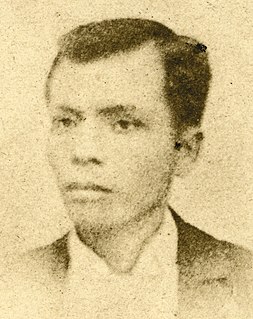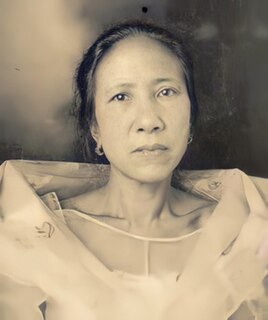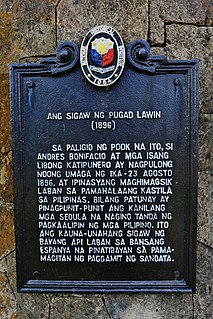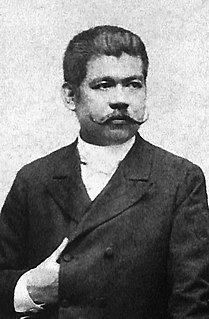Related Research Articles

The Katipunan, officially known as the Kataastaasan, Kagalanggalangang Katipunan ng mga Anak ng Bayan or Kataastaasan Kagalang-galang na Katipunan ng mga Anak ng Bayan, was a Philippine revolutionary society founded by anti-Spanish colonialist Filipinos in Manila in 1892; its primary goal was to gain independence from Spain through a revolution.

Andrés Bonifacio y de Castro was a Filipino Freemason and revolutionary leader. He is often called "The Father of the Philippine Revolution", and considered one of the national heroes of the Philippines. He was one of the founders and later the Kataastaasang Pangulo of the Kataastaasan, Kagalanggalangang Katipunan ng mga Anak ng Bayan or more commonly known as the "Katipunan", a movement which sought the independence of the Philippines from Spanish colonial rule and started the Tagalog Revolution. With the onset of the Revolution, Bonifacio reorganized the Katipunan into a revolutionary government, with himself as President (Pangulo) of a nation-state called "Haring Bayang Katagalugan", also "Republika ng Katagaluguan", wherein "Tagalog" referred to all those born in the Philippine islands and not merely the Tagalog ethnic group. Hence, some historians have argued that he should be considered the First President of the Tagalogs instead of the Philippines; that is why he is not included in the current official line of succession.

The Philippine Revolution, called the Tagalog War by the Spanish, was a revolution, a civil war and subsequent conflict fought between the people and insurgents of the Philippines and the Spanish colonial authorities of the Spanish East Indies, under the Spanish Empire.

Binondo is a district in Manila and is referred to as the city's Chinatown. Its influence extends beyond to the places of Quiapo, Santa Cruz, San Nicolas and Tondo. It is the oldest Chinatown in the world, established in 1594 by the Spaniards as a settlement near Intramuros but across the Pasig River for Catholic Chinese, it was positioned so that colonial rulers could keep a close eye on their migrant subjects. It was already a hub of Chinese commerce even before the Spanish colonial period. Binondo is the center of commerce and trade of Manila, where all types of business run by Filipino-Chinese thrive.
Miguel Malvar y Carpio was a Filipino general who served during the Philippine Revolution and, subsequently, during the Philippine–American War. He assumed command of the Philippine revolutionary forces during the latter, following the capture of resistance leader Emilio Aguinaldo by the Americans in 1901. According to some historians, he could have been listed as one of the presidents of the Philippines but, as of 2022, is not recognized as such by the Philippine government.

Mariano Álvarez was a Filipino revolutionary and statesman.

Ladislao Diwa y Nocon was a Filipino patriot who was among the founders of the Katipunan that initiated the Philippine Revolution against Spain in 1896.
José Matanza Dizon was a Filipino patriot who was among those who founded the Katipunan that sparked the Philippine Revolution

Gregoria de Jesús y Álvarez, also known by her nickname Oriang, was the founder and vice-president of the women's chapter of the Katipunan of the Philippines. She was also the custodian of the documents and seal of the Katipunan. She married Gat Andrés Bonifacio, the Supremo of the Katipunan and President of the Katagalugan Revolutionary Government. She played a major and one of the important roles in the Philippine Revolution. After the death of Bonifacio, she married Julio Nakpil, one of the generals of the revolution. She had one son from Andrés Bonifacio and five children from Julio Nakpil.

The Cry of Pugad Lawin was the beginning of the Philippine Revolution against the Spanish Empire.

The history of the Philippines from 1565 to 1898 is known as the Spanish colonial period, during which the Philippine Islands were ruled as the Captaincy General of the Philippines within the Spanish East Indies, initially under the Kingdom of the Viceroyalty of New Spain, based in Mexico City, until the independence of the Mexican empire from Spain in 1821. This resulted in direct Spanish control during a period of governmental instability there.

Marcelo Hilario del Pilar y Gatmaitán, commonly known as Marcelo H. del Pilar and also known by his pen name Pláridel, was a Filipino writer, lawyer, journalist, and freemason. Del Pilar, along with José Rizal and Graciano López Jaena, became known as the leaders of the Reform Movement in Spain.

The Battle of Binakayan–Dalahican was a simultaneous battle during the Philippine Revolution that was fought on November 9–11, 1896 that led to a decisive Filipino victory. The twin battle took place at the shores of Binakayan, in the town of Cavite Viejo ; Dalahican and Dagatan in Noveleta; and, to minimal extent, in Imus and Bacoor towns in Cavite, Philippines that lasted for two days before the Spanish army retreated demoralized and in disarray. The result of the battle was the first significant Filipino victory in the country's history.

The Battle of Manila of 1896 occurred in Manila in the Spanish colony of the Philippines during the Philippine Revolution. Katipunan under Andres Bonifacio attempted to take the city but the attempt failed, and Bonifacio retreated to the city's outskirts. The Battle of San Juan del Monte was joined a day later when Bonifacio attempted to capture the San Juan's powder magazine, but this too failed.

The Thirteen Martyrs of Bagumbayan were Filipino patriots in the Philippines who were executed by musketry on January 11, 1897, for cooperating with the Katipunan during the Philippine Revolution against Spain.

Morong was an administrative division of the Philippines existing as a politico-military district created out of parts of the provinces of Tondo and Laguna on February 23, 1853 by a decree of the Superior Gobierno, composing Morong, Pililla, Tanay, Baras, Binangonan, Jalajala, Angono and Cardona from Laguna; and Antipolo, Boso-Boso, Cainta and Taytay from Tondo. The offices were housed at a building now known as Comandancia. Its first military governor was Francisco Turrentigue.

Bonifacio: Ang Unang Pangulo is a 2014 Philippine historical action drama film centering on the life of Katipunan revolutionary Andres Bonifacio. It was an official entry to the 40th Metro Manila Film Festival.

The Liwasang Bonifacio, also known by its former name, Plaza Lawton, is a city square and transport hub in front of the Manila Central Post Office in the Ermita district of Manila, Philippines. It lies at the south end of Jones Bridge, MacArthur Bridge, and Quezon Bridge that link the northern districts of Binondo, Santa Cruz, and Quiapo to the central district of Ermita. The plaza straddles the dividing line between Ermita and Intramuros and is the starting point of Padre Burgos Avenue which connects to Taft Avenue and Roxas Boulevard in Rizal Park.
Mariano Limjap was a Filipino revolutionary who is part of the Katipunan (KKK). He was a businessman, philanthropist, and nationalist. He was incarcerated by the Spanish for funding the Manila battalion when in fact his only "crime" was patriotism. After the Philippine–American War, he was included in the committee for the creation of a Rizal monument in Luneta as decreed by Act No. 243, approved by the United States Philippine Commission.
This is the timeline of the Philippine Revolution. It contains the events before and during the revolution.
References
- 1 2 3 4 5 6 7 8 9 10 11 "Filipinos in History: Luis Yangco". National Historical Commission of the Philippines . Retrieved August 12, 2019.
- 1 2 3 4 5 6 7 8 9 10 11 "Luis Yangco". Cavite Revolutionary Figures and Martyrs. Cavite State University . Retrieved August 12, 2019.
- 1 2 3 Ang See, Teresita. "The Fires of Revolution: Shared History, Shared Destiny". Chinese Studies Program Lecture Series. Ateneo de Manila University . Retrieved August 12, 2019.